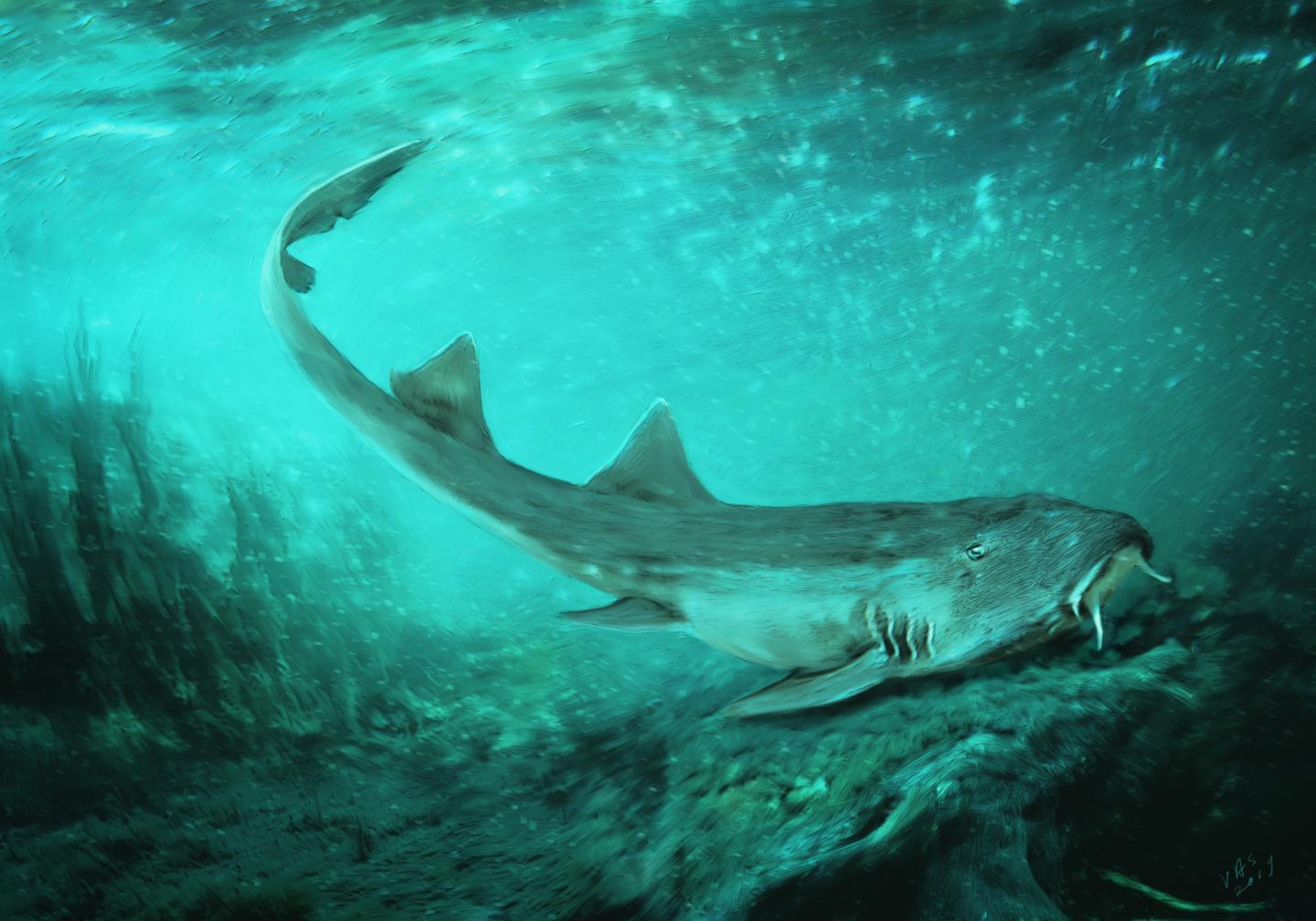Freshwater shark lived in South Dakota, had teeth shaped like ‘Galaga’ spaceships

Credit: (c) Velizar Simeonovski, Field Museum
SUE the T. rex is the most famous fossil from the Hell Creek Formation of South Dakota–the most complete skeleton ever discovered of the world’s most popular dinosaur. When Field Museum scientists removed the rock surrounding SUE’s bones twenty years ago, they kept the leftover sediment (called matrix). For decades, the leftover matrix sat in underground storage at the museum, until scientists and volunteers began meticulously picking through it in search of tiny fossils. They found the remains of a shark that lived in a river SUE probably drank from.
“This shark lived at the same time as SUE the T. rex, it was part of the same world,” says Pete Makovicky, the Field Museum’s curator of dinosaurs and one of the authors of the Journal of Paleontology study describing the new species. “Most of its body wasn’t preserved, because sharks’ skeletons are made of cartilage, but we were able to find its tiny fossilized teeth.”
The team, led by North Carolina State University’s Terry Gates, named the shark Galagadon nordquistae, a nod to its teeth, which have a stepped triangle shape like the spaceships in the 1980s video game Galaga, and to Karen Nordquist, the Field Museum volunteer who discovered the fossils.
“It was so tiny, you could miss it if you weren’t looking really carefully,” says Nordquist, a retired chemist who has been microsorting, or sifting through dirt to find tiny fossils, for the Field Museum for fifteen years. “To the naked eye, it just looks like a little bump, you have to have a microscope to get a good view of it.”
The teeth are only a millimeter wide–about the diameter of the head of a pin–and the shark they belonged to was small too. “Galagadon was less than two feet long–it’s not exactly Jaws,” says Makovicky. “It’s comparable to bamboo sharks living today. It probably had a flat face and was very likely camouflage-colored, since its relatives today have a camouflage pattern. It would have eaten small invertebrates and probably spent a fair amount of time lying on the bottom of the riverbed.”
But while Galagadon wasn’t breaking any size records, its discovery is making scientists question what they thought they knew about the area where SUE the T. rex was found. “We had always thought of the SUE locality as being by a lake formed from a partially dried-up river–the presence of this shark suggests there must have been at least some connection to marine environments,” says Makovicky. “This wasn’t some Sharknado event–these animals were making their way up rivers from the sea.”
“Today, carpet sharks, which include bamboo sharks and wobbegongs, mostly live in the waters in southeast Asia and Australia, so it’s surprising to find their fossils at the SUE locality. During the Late Cretaceous the continents continued to drift apart, further isolating dinosaurs and other land animals, and at the same time created the Atlantic and Indian oceans. With occasional seaways connecting these young oceans, we have found fossils of marine life flourishing globally, including Galagadon and its relatives. ” says Eric Gorscak, a research associate at the Field Museum and another author on the study.
The study also reflects the importance of learning about fossils beyond big, flashy dinosaurs. “Every species in an ecosystem plays a supporting role, keeping the whole network together,” says Terry Gates, lecturer at North Carolina State University and a research affiliate with the North Carolina Museum of Natural Sciences and lead author of the paper describing the shark. “There is no way for us to understand what changed in the ecosystem during the time of the mass extinction at the end of the Cretaceous without knowing all the wonderful species that existed before.”
“Most people, when they think of fossils, think of big huge dinosaur bones, but in the dirt, there are the bones of tiny animals,” says Nordquist. “When you get those bones and identify them, you get an idea of the whole environment–everything that lived with the big dinosaurs. You learn so much from microsorting.”
###
Media Contact
Kate Golembiewski
[email protected]
773-806-9852




